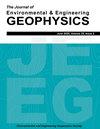用于化粪池设计的沙漠干旱区三维时域诱导极化
IF 0.7
4区 工程技术
Q4 ENGINEERING, GEOLOGICAL
引用次数: 0
摘要
在干旱的美国西南部,化粪池浸出场的设计需要对土壤进行直接测试,以确保足够的排水。我们建议,如果使用电地球物理方法来确定有利于适当排水速率的土壤结构,则可以减少直接测试成本。我们在一个居民区演示了这一概念,在粘土(Argid)和钙质(Orthid)成分的不同混合物的沙漠土壤中获得了电阻率和诱导极化数据。在反演建模过程中,对电极阵列进行了测试,以确保高数据质量和最小的工作量。由此产生的电阻率结构确定了该属性的东半部和西半部之间的明显边界。西部比东部的导电性更强,这可能表明存在更高的水分或更高的粘土含量。从诱导极化调查中收集的可充电性数据显示,该物业的东西两部分之间存在类似的鲜明模式。根据高荷电性值和直接从坑中进行的土壤测试,证实了调查区西部有一些粘土。挖至3.65 m的试验坑表现出高温和高温的过渡状态;试验坑位于中等电阻率和低充电率的位置。从这项研究中,我们得出结论,电阻率和IP在化粪池设计中是有用的,因为当根据地球物理结果仔细选择测试位置时,它们减少了所需的直接测试总量。本文章由计算机程序翻译,如有差异,请以英文原文为准。
Three-dimensional Time-domain Induced Polarization of a Desert Aridisol for Septic Design
Septic leach field design in the arid southwestern US requires direct testing of soils to ensure adequate drainage. We propose that direct testing costs can be reduced if electrical geophysical methods are used to determine soil structure that facilitates proper drainage rates. We demonstrate this concept at a residential site where resistivity and induced polarization data were acquired within a desert soil with variable mixtures of clay (Argid) and calcareous (Orthid) components. Electrode arrays were tested to ensure high data quality and minimal workload during inversion modeling. The resulting resistivity structure identified a sharp boundary between the eastern and western halves of the property. The west was more conductive than the east, which could indicate the presence of higher moisture or higher clay content. Chargeability data gathered from the induced polarization survey showed similar stark patterns between east and west halves of the property. The western portion of the survey area was verified to have some clay based on high chargeability values and direct soil testing from pits. Test pits dug to 3.65 m showed transitions between Argid and Othid conditions; the test pits were in locations of moderate resistivity and low chargeability. From this study, we concluded that resistivity and IP were useful in septic design because they reduce the total amount of direct testing needed when testing locations are carefully chosen based on the geophysical results.
求助全文
通过发布文献求助,成功后即可免费获取论文全文。
去求助
来源期刊

Journal of Environmental and Engineering Geophysics
地学-地球化学与地球物理
CiteScore
2.70
自引率
0.00%
发文量
13
审稿时长
6 months
期刊介绍:
The JEEG (ISSN 1083-1363) is the peer-reviewed journal of the Environmental and Engineering Geophysical Society (EEGS). JEEG welcomes manuscripts on new developments in near-surface geophysics applied to environmental, engineering, and mining issues, as well as novel near-surface geophysics case histories and descriptions of new hardware aimed at the near-surface geophysics community.
 求助内容:
求助内容: 应助结果提醒方式:
应助结果提醒方式:


